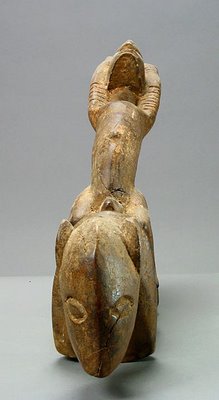
I have been shattered
This shattering involves both my sense of incompleteness as to the meaning of my life, as expressed in my sense of being a traveller on earth who, has lost his way in a journey of which birth and death are but stages as well as my present conundrum of crisis in my marriage in which the certainties by which I had played my role in the marriage have been destroyed and I have found nothing to replace them. It also involves my separation from my children who are all the way in Nigeria while I am in London.
This separation is made all the more acute by the fact that it has been initiated by their mother who has schemed to gain control of them while isolating me in London, thereby creating the impression that I do not care for the children when I badly wanted us all to come to London and share in the quality of life I have always wanted but which my father was not able to give my sisters and I since he came to England and isolated my sisters and my mum from his life. The role of absentee father, a role I dread since I have suffered from it as a child, has been thrust on me by my children’s mother. But I will prevail against it.
Top:Nommo figure from the Dogon of Mali.
Displayed and described by the Barakat Gallery:
"Inhabiting the barren cliffsides of the Bandiagara Escarpment, near the great bend of the Niger River, the Dogon people led lives of physical austerity and spiritual wealth. They often performed religious ceremonies in which the arts played a crucial role. Ceremonies known as "rites of passage" mark the major life cycles, such as initiation or celebrations. Used in such rituals, the Dogon art form is always laden with rich symbolism, expressing their beliefs.
This majestic yet puzzling work depicts a man riding an animal, arms stretched upwards as though in the motion of bowing forward in prayer or pulling dramatically on reigns. The animal's identity remains ambiguous as it no longer has its legs and fails to resemble a horse. Further, the manner in which the man kneels upon rather than straddles the animal is another convention implemented by the Dogon and Tellem peoples along with the characteristic under-defined features and body forms. Similar representations are attributed to the Dogon of the 20th century, however exact dating of this piece is unknown. They seem to have been employed in a religious fashion by a "Hogon" or political and spiritual advisor to the village or region as protector figures."
elaborated upon by Fayez Barakat in relation to a similar figure at artnet:
"The Dogon of Mali have maintained their tribal culture with great tenacity in their rocky fortress above the Bandiagara escarpment. In sculpture, they are among the outstanding tribes of Africa, producing marvelous wooden sculptures. Although wood is the material most often used by the artists of Africa, no African undertaking is entirely free and gratuitous--wood sculptures carry special significance. Since wood is a living material, it is felt that the sculptures derive their magical power from the earth and whose leaves received water from the sky. The process of sculpting the wood, thus, is the transmutation of power through modification of form. this magnificent sculpture is a representation of Nommo, a spirit who plays an essential role in the Dogon cosmogony.
The Dogon mythology describes Nommo as the spirit sacrificed to heaven, his body hacked into five parts which are thrown, respectively, to the four cardinal points and to the center of the quadrangle. as shown by this wooden sculpture, Nommo are sometimes represented as a figure with uplifted arms, imploring rain, evoking ideas of fertility and birth, of purification of primeval realm, and of the life-force. Sculpted in a graceful manner, the Nommo rides a mythical animal, leaning back with his arms raised up straight. Such fine juxtaposition of the shapes creates physical and spatial harmony. Beautiful in form and fascinating in history, this wonderful sculpture certainly is to bring the magic for times to come, as noted in the ancient Dogon mythology".
The tension realized through the backward leaning posture of the ruder,in contrast to the forward movement of the mount,evokes the sense of tension between polarities that characterises traditional Dogonconceptions of human growth.
The human being is understood as a composite of a male and a female soul,sundered at the beginnig of time in the Nommo,the archtypal beings.The task of human life is to grow into wholeness which invoves the integration of these two aspects of self.
This growth is described in terms of becoming the Nommo,the archeptypal person.As a child,one is expressive of a partail aspct of Nommo,ass one grows,one becomes expressive of more inclusive aspects of Nommo,till one has become expressive of the complete Nommo,of Nommo in their entirety.
This blog is an account of the writer's development.
It could be understood, therefore, in terms of an effort to interpret his exprience in relation to such models that recognise the human sense of psychological disruption and the need for integration as the myth of the Nommo and that of the divine sparks in Kabbalah.


0 Comments:
Post a Comment
<< Home